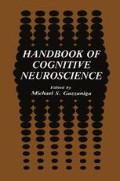Abstract
It is of interest to determine how the presence of language in a neural network changes the cognitive capacity of that system. Disentangling cognition from language is always difficult. One approach is to establish a measurable level of cognitive skills in an organism and then see how it advances or retreats as a function of the independent introduction of language (Premack, 1982). Another is to study language-competent organisms that have fallen into disrepair and to look at changes in normal cognitive function (Goldstein, 1948; Luria, 1969).
Access this chapter
Tax calculation will be finalised at checkout
Purchases are for personal use only
Preview
Unable to display preview. Download preview PDF.
References
Gazzaniga, M. S. The bisected brain. New York: Appleton-Century-Crofts, 1970.
Gazzaniga, M. S. Right hemisphere language: A twenty year perspective. American Psychologist. 1983, 38. 525 - 549.
Gazzaniga. M. S., & LeDoux, J. E. The integrated mind. New York: Plenum Press, 1978.
Gazzaniga, M. S., & Smylie, C. S. Facial recognition and brain assymetries: Clues to underlying mechanisms. Annals of Neurology, 1983, 13, 536 - 540.
Gazzaniga, M. S., & Smylie, C. S. Facial recognition and brain assymetries: Clues to underlying mechanisms. Annals of Neurology, 1983, 13, 536 - 540.
Gazzaniga, M. S., & Sperry. R. W. Language after section of the cerebral commissures. Brain 1967, 90, 131 - 148.
Gazzaniga, M. S., & Volpe, B. T. Split-brain studies: Implications for psychiatry. In S. Arieti & H. K. H. Brodie (Eds.), American handbook of psychiatry, VII (2nd ed.). New York: Basic Books, 1981.
Gazzaniga, M. S., Bogen, J. E., & Sperry, R. W. Some functional effects of sectioning the cerebral commissures in man. Proceedings of the National Academy of Science, 1962, 48, 1765 - 1769.
Gazzaniga, M. S., Bogen, J. E., & Sperry, R. W. Observations of visual perception after disconnexion of the cerebral hemispheres in man. Brain, 1965, 88, 221 - 230.
Gazzaniga, M. S., Bogen, J. E., & Sperry, R. W. Dyspraxia following division of the cerebral commissures. Archives of Neurology, 1967, 16, 606–612.
Gazzaniga, M. S., Wilson, D. H., & LeDoux, J. E. Language, praxis, and the right hemisphere: Clues to some mechanisms of consciousness. Neurology, 1977, 27, 1144 - 1147.
Gazzaniga, M. S., Volpe, B. T., Smylie, C. S., Wilson, D. H., & LeDoux, J. E. Plasticity in speech organization following commissurotomy. Brain, 1979,102, 805-815.
Gazzaniga, M. S., Sidtis, J.J., Volpe, B. T., Smylie, C. S., Holtzman, J. O., & Wilson, D. H. Evidence for para-callosal transfer after callosal section: A possible consequence of bilateral language organization. Brain 1982, 105, 53-63.
Goldstein, K. Language anti language disturbances. New York: Grune & Stratton, 1948.
Holtzman, J. 0., & Gazzaniga, M. S. Temporal order recognition and the right hemisphere, 1982.
Holtzman, J. D., Sidtis, J. J., Volpe, B. T., Wilson, D. H. & Gazzaniga, M. S. Dissociation of spatial information for stimulus localization and the control of attention. Brain, 1981, 104, 861 - 872.
Holtzman, J. D., Volpe, B. T., & Gazzaniga, M. S. The integrity of attentional control following commissural section. In R. Parasuraman, D. R. Davies, & J. Beaty (eds.), Varieties of attentional control. New York: Academic Press, 1982.
LeBrun, Y., & Hoopes, R. (Eds.) 1ntelligence anti aphasia. Amsterdam: Swets and Zeitlinger B. V., 1974.
LeDoux, J. E., Smylie, C. S., Ruff, R., & Gazzaniga, M. S. Visual processes of the left hemisphere in a case of right parietal symptomolgy: Implications for theories of cerebral lateralization. Archives of Neurology, 1980, 37, 157 - 159.
Levy, J., Trevarthen C.,& Sperry, R. W. Perception of bilateral chimeric figures following hemispheric disconnection. Brain, 1972, 95; 61 - 78.
Luria, A. K. Traumatic aphasia. The Hague: Mouton, 1969.
Milner, B., & Taylor, L. Right hemisphere superiority in tactile pattem-recognition after cerebral commissurotomy: Evidence for nonverbal memory. Neurophychologia, 1972, 10, 1-15.
Nebes, R. D. Superiority of the minor hemisphere in commissurotomized man for the perception of part whole relations. Cortex, 1971, 7, 333 - 349.
Premack, D. Characteristics of an upgraded mind. Brain anti Behavioral Science, 1983, 6, 125 - 167.
Rasmussen, T., & Milner, B. The role of early left-brain injury in determining lateralization of cerebral speech functions. In S. J. Dimond & D. A. Blizard (Eds.), Evolution arid lateralization of the brain (Vol. 299 ). New York: New York Academy of Science, 1977.
Sidtis, J. J., & Gazzaniga, M. S. Competence versus performance after callosal section: Looks can be deceiving. In J. B. Heilige (Ed.), Cerebral hemisphere asymmetry: Method, theory, anti application. New York: Praeger, 1983.
Sidtis, J. J., Volpe, B. T., Wilson, D. H., Rayport, M., & Gazzaniga, M. S. Variability in right hemisphere language function after callosal section: Evidence for a continuum of generative capacity. Journal of Neuroscience, 1981, 1, 323 - 331.
Sidtis, J. J., Volpe, B. T., Holtzman, J. A., Wilson, D. A., & Gazzaniga, M. S. Cognitive interactions after staged callosal surgery: Evidence for transfer of semantic activation. Science, 1981, 212, 344 - 346.
Volpe, B. T., Sidtis, J. J., Holtzman, J. D., Wilson, D. H., & Gazzaniga, M. S. Cortical mechanisms involved in praxis: Observations following partial and complete callosal section. Neurology, 1982, 32, 645 - 650.
Woods, B. T. The restricted effects of right-hemisphere lesions after age one: Wechsler test data. Neuropsychologia, 1980, 18, 65 - 70.
Zaidel, E. Lexical organization in the right hemisphere. In P. A. Buser & A. Rougel-Buser (Eds.), Cerebral correlates of conscious experience. Amsterdam: North-Holland Publishing Co., 1977.
Author information
Authors and Affiliations
Editor information
Editors and Affiliations
Rights and permissions
Copyright information
© 1984 Springer Science+Business Media New York
About this chapter
Cite this chapter
Gazzaniga, M.S., Smylie, C.S. (1984). What Does Language Do for a Right Hemisphere?. In: Gazzaniga, M.S. (eds) Handbook of Cognitive Neuroscience. Springer, Boston, MA. https://doi.org/10.1007/978-1-4899-2177-2_10
Download citation
DOI: https://doi.org/10.1007/978-1-4899-2177-2_10
Publisher Name: Springer, Boston, MA
Print ISBN: 978-1-4899-2179-6
Online ISBN: 978-1-4899-2177-2
eBook Packages: Springer Book Archive

